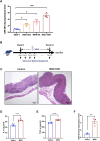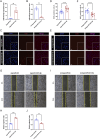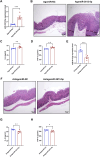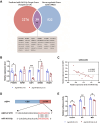MiR-3613-5p targets AQP4 to promote the progression of chronic atrophic gastritis to gastric cancer
- PMID: 40255569
- PMCID: PMC12006049
- DOI: 10.3389/fphar.2025.1523689
MiR-3613-5p targets AQP4 to promote the progression of chronic atrophic gastritis to gastric cancer
Abstract
Introduction: Gastric cancer (GC) exhibits high invasiveness, delayed diagnosis, and poor prognosis. Chronic atrophic gastritis (CAG), an initial stage within the Correa cascade, induces gastric mucosal inflammation and atrophy, promoting genetic and epigenetic alterations. MicroRNAs (miRNAs) dysregulation has been implicated in gastric tumorigenesis, yet their specific roles in CAG progression to GC remain unclear. Methods: Using clinical data from the GEO database, we identified miRNAs differentially expressed in gastric mucosa and serum samples from GC patients. Murine CAG models were established through administration of N-methyl-N-nitrosourea (MNU) and high-salt diet (HSD). In vitro functional assays evaluated proliferation and migration after miRNA modulation in gastric cancer cell lines. MiRNA target validation involved luciferase reporter assays. Results: MiR-3613-5p expression was significantly elevated in gastric mucosal and serum samples of GC patients, mucosal tissues of CAG patients, tumor tissues, and human gastric cancer cell lines. Murine models demonstrated increased miR-3613-5p expression in gastric mucosa following MNU and HSD-induced CAG. Functionally, miR-3613-5p overexpression promoted gastric cancer cell proliferation and migration in vitro, whereas silencing miR-3613-5p alleviated pathological gastric mucosal alterations (atrophy, hyperplasia, inflammatory infiltration) in vivo. Mechanistically, miR-3613-5p inhibited Aquaporin 4 (AQP4) expression by directly targeting its 3'UTR. Discussion: Our findings provide the first evidence that miR-3613-5p facilitates CAG progression toward GC via negative regulation of AQP4. These results highlight miR-3613-5p as a promising biomarker and therapeutic target, suggesting antagomiR-3613-5p as a potential novel strategy to prevent gastric carcinogenesis.
Keywords: Aquaporin 4; chronic atrophic gastritis; gastric cancer; intestinal metaplasia; miR-3613-5p.
Copyright © 2025 Bi, Wang and Wang.
Conflict of interest statement
The authors declare that the research was conducted in the absence of any commercial or financial relationships that could be construed as a potential conflict of interest.
Figures







Similar articles
-
miR-196a-5p Correlates with Chronic Atrophic Gastritis Progression to Gastric Cancer and Induces Malignant Biological Behaviors of Gastric Cancer Cells by Targeting ACER2.Mol Biotechnol. 2023 Aug;65(8):1306-1317. doi: 10.1007/s12033-022-00589-8. Epub 2022 Dec 13. Mol Biotechnol. 2023. PMID: 36513872
-
Identification of non-invasive biomarkers for chronic atrophic gastritis from serum exosomal microRNAs.BMC Cancer. 2019 Feb 8;19(1):129. doi: 10.1186/s12885-019-5328-7. BMC Cancer. 2019. PMID: 30736753 Free PMC article.
-
High-throughput sequencing analysis of differential microRNA expression in the process of blocking the progression of chronic atrophic gastritis to gastric cancer by Xianglian Huazhuo formula.J Tradit Chin Med. 2024 Aug;44(4):703-712. doi: 10.19852/j.cnki.jtcm.20240617.002. J Tradit Chin Med. 2024. PMID: 39066531 Free PMC article.
-
Atrophic gastritis and gastric cancer tissue miRNome analysis reveals hsa-miR-129-1 and hsa-miR-196a as potential early diagnostic biomarkers.World J Gastroenterol. 2022 Feb 14;28(6):653-663. doi: 10.3748/wjg.v28.i6.653. World J Gastroenterol. 2022. PMID: 35317427 Free PMC article.
-
GADD45B regulates the carcinogenesis process of chronic atrophic gastritis and the metabolic pathways of gastric cancer.Front Endocrinol (Lausanne). 2023 Aug 7;14:1224832. doi: 10.3389/fendo.2023.1224832. eCollection 2023. Front Endocrinol (Lausanne). 2023. PMID: 37608794 Free PMC article.
References
-
- Ahmadi M., Najari-Hanjani P., Ghaffarnia R., Ghaderian S. M. H., Mousavi P., Ghafouri-Fard S. (2023). The hsa-miR-3613-5p, a potential oncogene correlated with diagnostic and prognostic merits in kidney renal clear cell carcinoma. Pathology, Res. Pract. 251, 154903. 10.1016/j.prp.2023.154903 - DOI - PubMed
-
- Akhavanfar R., Shafagh S. G., Mohammadpour B., Farahmand Y., Lotfalizadeh M. H., Kookli K., et al. (2023). A comprehensive insight into the correlation between ncRNAs and the Wnt/β-catenin signalling pathway in gastric cancer pathogenesis. Cell Commun. Signal. CCS 21 (1), 166. 10.1186/s12964-023-01092-6 - DOI - PMC - PubMed
Associated data
LinkOut - more resources
Full Text Sources
Miscellaneous

